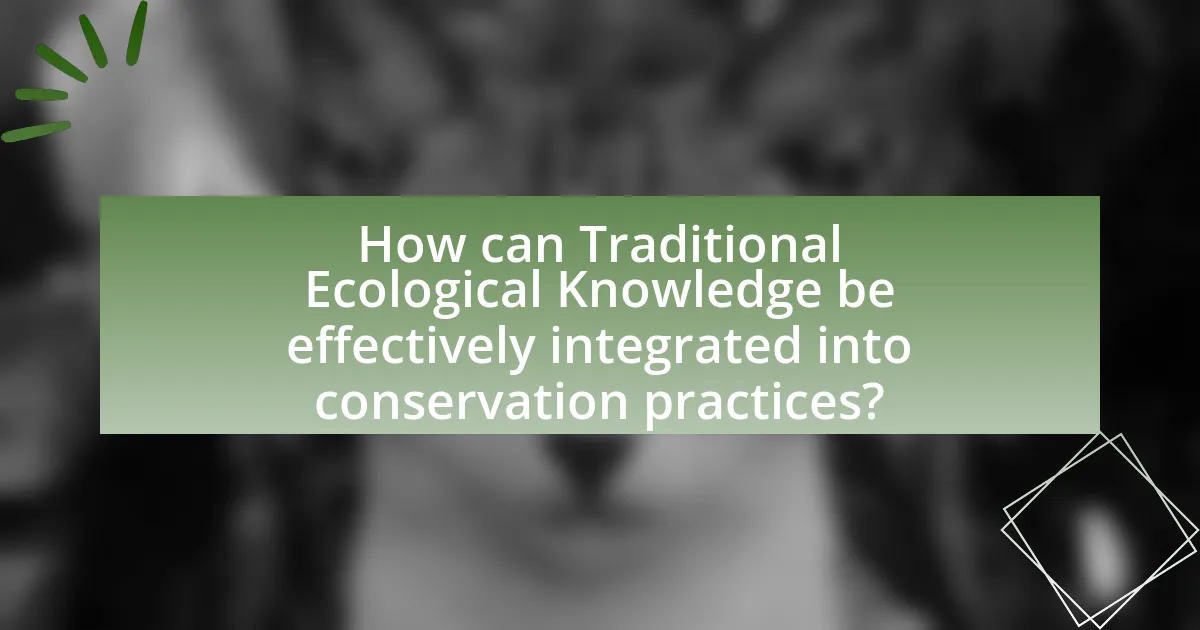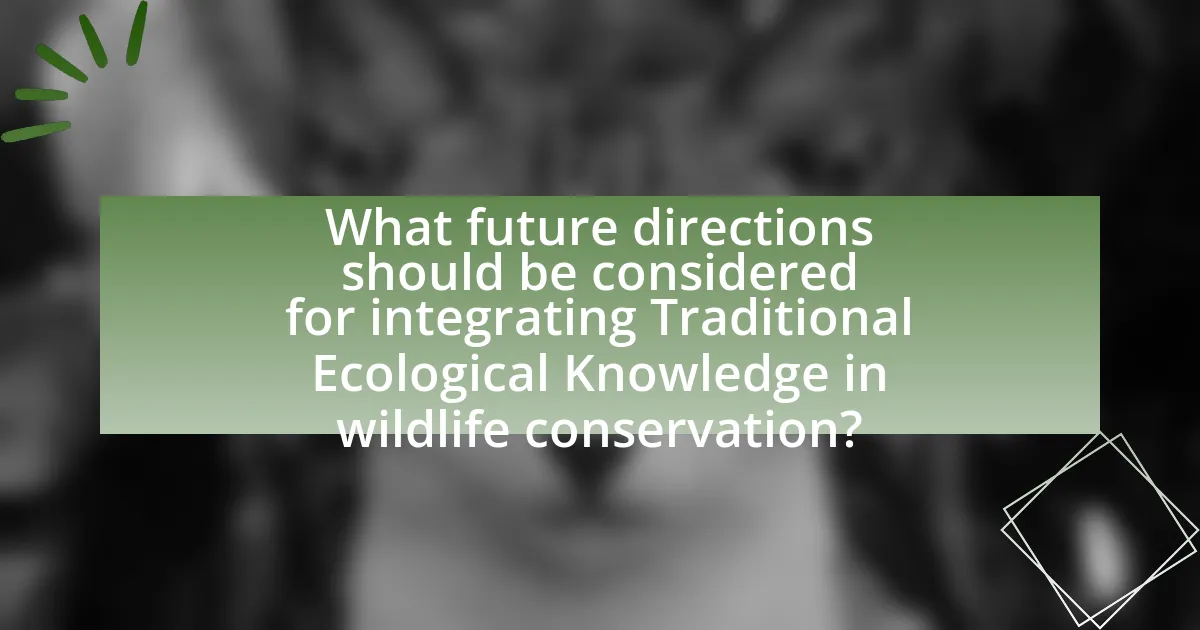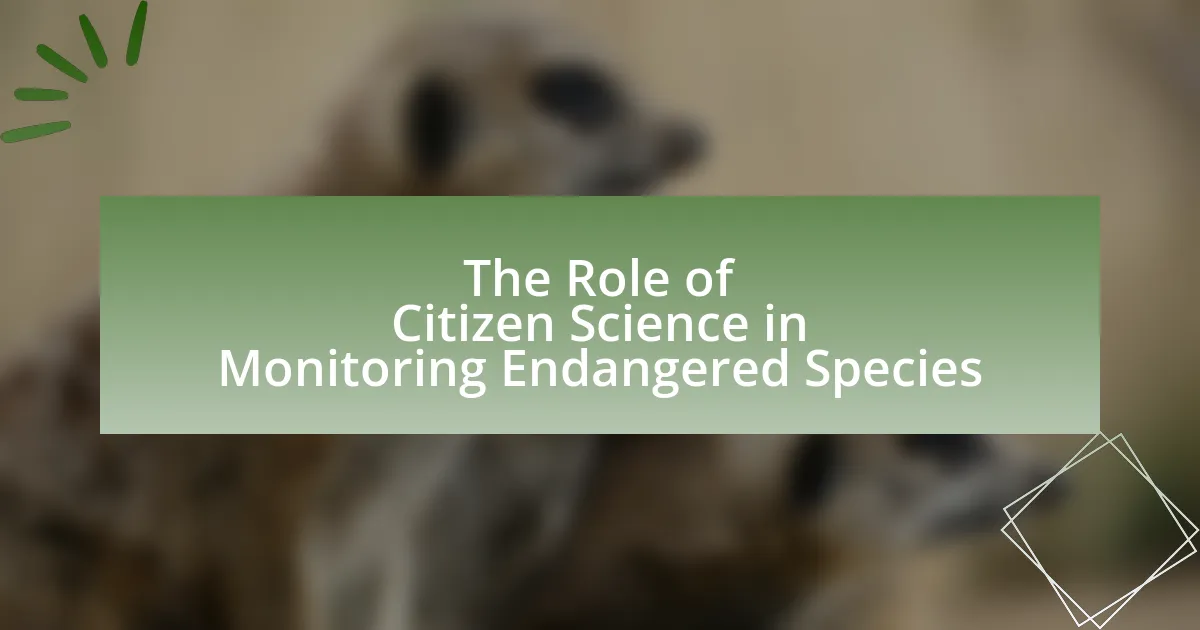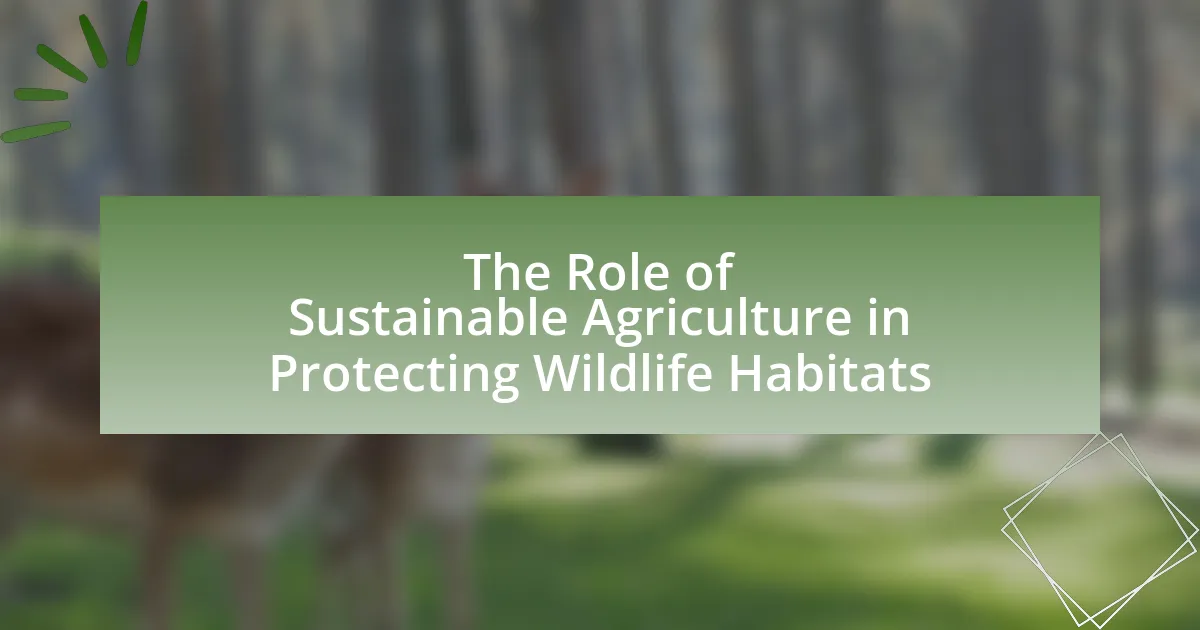Integrating Traditional Ecological Knowledge (TEK) in wildlife conservation strategies involves the incorporation of indigenous and local knowledge systems into contemporary conservation practices. This approach recognizes the long-standing relationships between indigenous communities and their environments, enhancing biodiversity management and ecosystem resilience. The article discusses how TEK contributes to wildlife conservation by providing insights into sustainable practices, habitat management, and species behavior, often leading to improved conservation outcomes. It also addresses the challenges of integrating TEK with scientific methods, the importance of community involvement, and successful case studies that exemplify the benefits of this integration for biodiversity preservation. Additionally, it outlines future directions and best practices for effectively incorporating TEK into conservation efforts.

What is Integrating Traditional Ecological Knowledge in Wildlife Conservation Strategies?
Integrating Traditional Ecological Knowledge (TEK) in wildlife conservation strategies involves incorporating indigenous and local knowledge systems into modern conservation practices. This integration recognizes the value of long-standing relationships between indigenous communities and their environments, which can enhance biodiversity management and ecosystem resilience. Research indicates that TEK can provide insights into species behavior, habitat management, and sustainable resource use, often leading to more effective conservation outcomes. For example, studies have shown that areas managed with TEK principles often exhibit higher biodiversity levels compared to those managed solely by conventional scientific methods.
How does Traditional Ecological Knowledge contribute to wildlife conservation?
Traditional Ecological Knowledge (TEK) contributes to wildlife conservation by providing insights into sustainable practices and ecosystem management based on generations of indigenous experience. TEK encompasses the understanding of local species, their behaviors, and the ecological relationships within their habitats, which can enhance conservation strategies. For example, research has shown that indigenous land management practices, such as controlled burns, can improve habitat quality for various wildlife species, thereby increasing biodiversity. Additionally, TEK often emphasizes the importance of cultural values and community involvement in conservation efforts, leading to more effective and culturally relevant wildlife management practices. This integration of TEK into modern conservation approaches has been documented in studies, such as those published in the journal “Ecological Applications,” highlighting its effectiveness in preserving both biodiversity and cultural heritage.
What are the key principles of Traditional Ecological Knowledge?
The key principles of Traditional Ecological Knowledge (TEK) include a deep understanding of local ecosystems, the interconnection between humans and nature, and the importance of cultural practices in resource management. TEK emphasizes the significance of experiential knowledge passed down through generations, which informs sustainable practices and biodiversity conservation. For instance, Indigenous communities often utilize TEK to manage land and resources effectively, demonstrating its practical application in maintaining ecological balance. Studies have shown that integrating TEK with scientific approaches can enhance conservation outcomes, as evidenced by successful wildlife management programs that incorporate Indigenous knowledge systems.
How does Traditional Ecological Knowledge differ from scientific approaches?
Traditional Ecological Knowledge (TEK) differs from scientific approaches primarily in its foundation; TEK is based on the cumulative knowledge, practices, and beliefs developed by indigenous and local communities over generations, while scientific approaches rely on systematic observation, experimentation, and empirical evidence. TEK emphasizes a holistic understanding of ecosystems, integrating cultural, spiritual, and historical contexts, whereas scientific methods prioritize quantifiable data and reproducibility. For instance, TEK often includes insights about seasonal changes and species behavior that are informed by long-term observation, which may not be captured in short-term scientific studies. This distinction highlights the complementary roles of TEK and scientific approaches in wildlife conservation, as both can provide valuable insights for sustainable management practices.
Why is integrating Traditional Ecological Knowledge important for wildlife conservation?
Integrating Traditional Ecological Knowledge (TEK) is important for wildlife conservation because it provides valuable insights into local ecosystems and species interactions that are often overlooked by conventional scientific approaches. TEK, developed over generations by Indigenous and local communities, encompasses a deep understanding of biodiversity, seasonal changes, and sustainable resource management practices. For instance, studies have shown that areas managed with TEK principles often exhibit higher biodiversity and resilience to environmental changes compared to those managed solely through modern scientific methods. This integration enhances conservation strategies by combining empirical data with culturally relevant practices, leading to more effective and sustainable outcomes for wildlife conservation.
What are the benefits of combining Traditional Ecological Knowledge with modern conservation strategies?
Combining Traditional Ecological Knowledge (TEK) with modern conservation strategies enhances biodiversity conservation and ecosystem management. TEK provides valuable insights into local ecosystems, species behaviors, and sustainable practices developed over generations, which can complement scientific approaches. For instance, studies have shown that integrating TEK can lead to improved habitat restoration outcomes, as local communities often possess detailed knowledge about native species and ecological processes. Furthermore, the inclusion of TEK fosters community engagement and stewardship, leading to more effective conservation efforts, as seen in various successful projects worldwide, such as the collaborative management of marine resources in the Pacific Islands.
How does this integration enhance biodiversity conservation efforts?
Integrating Traditional Ecological Knowledge (TEK) enhances biodiversity conservation efforts by incorporating indigenous practices and insights that have been developed over generations. This integration allows for a more holistic understanding of ecosystems, as TEK often emphasizes the interconnectedness of species and their habitats. For example, studies have shown that areas managed with TEK principles can exhibit higher levels of biodiversity and ecosystem resilience compared to those managed solely through conventional scientific methods. This is evidenced by research conducted in various regions, such as the Amazon rainforest, where indigenous land management practices have led to the preservation of diverse plant and animal species.
What challenges exist in integrating Traditional Ecological Knowledge into wildlife conservation?
Integrating Traditional Ecological Knowledge (TEK) into wildlife conservation faces several challenges, primarily including differing worldviews, lack of recognition, and communication barriers. The differing worldviews between Indigenous knowledge systems and Western scientific approaches can lead to misunderstandings and conflicts in conservation goals. Additionally, TEK is often not formally recognized within legal and policy frameworks, which can marginalize Indigenous voices and limit their participation in conservation efforts. Communication barriers arise from differences in language and terminology, making it difficult for scientists and Indigenous practitioners to collaborate effectively. These challenges hinder the effective integration of TEK into wildlife conservation strategies, limiting the potential benefits of combining traditional and scientific knowledge for biodiversity preservation.
What are the barriers to collaboration between Indigenous communities and conservationists?
Barriers to collaboration between Indigenous communities and conservationists include differing worldviews, historical mistrust, and inadequate recognition of Indigenous rights. Indigenous communities often prioritize cultural and spiritual connections to land, while conservationists may focus on scientific approaches, leading to conflicting objectives. Historical injustices, such as land dispossession and marginalization, contribute to mistrust, making collaboration challenging. Additionally, many conservation initiatives fail to adequately recognize and incorporate Indigenous rights and knowledge systems, which can hinder effective partnerships. For instance, a study published in the journal “Conservation Biology” highlights that successful collaboration requires mutual respect and acknowledgment of Indigenous sovereignty, which is often lacking in conservation frameworks.
How can misunderstandings about Traditional Ecological Knowledge be addressed?
Misunderstandings about Traditional Ecological Knowledge (TEK) can be addressed through education and collaborative engagement with Indigenous communities. Education initiatives should focus on disseminating accurate information about TEK’s principles, practices, and its role in biodiversity conservation. Collaborative engagement involves involving Indigenous peoples in decision-making processes, ensuring their knowledge is respected and integrated into conservation strategies. Research indicates that when Indigenous knowledge is combined with scientific approaches, it leads to more effective conservation outcomes, as seen in various case studies where TEK has successfully informed wildlife management practices.

How can Traditional Ecological Knowledge be effectively integrated into conservation practices?
Traditional Ecological Knowledge (TEK) can be effectively integrated into conservation practices by actively involving Indigenous communities in decision-making processes and management strategies. This integration ensures that local ecological insights and cultural values inform conservation efforts, leading to more sustainable outcomes. For instance, studies have shown that areas managed with TEK often exhibit higher biodiversity and resilience, as Indigenous practices are tailored to local ecosystems over generations. Furthermore, collaborative frameworks that respect and incorporate TEK have been successfully implemented in various regions, such as the co-management of marine resources in Canada, which combines scientific research with Indigenous knowledge to enhance conservation effectiveness.
What methods can be used to incorporate Traditional Ecological Knowledge in conservation planning?
Methods to incorporate Traditional Ecological Knowledge (TEK) in conservation planning include participatory mapping, collaborative research, and community-based monitoring. Participatory mapping allows local communities to share their ecological knowledge spatially, identifying important habitats and resources. Collaborative research engages Indigenous and local knowledge holders in scientific studies, ensuring that TEK informs data collection and analysis. Community-based monitoring empowers local populations to track environmental changes and biodiversity, integrating their observations into formal conservation strategies. These methods have been shown to enhance the effectiveness of conservation efforts by aligning them with local ecological practices and cultural values.
How can participatory approaches facilitate the integration process?
Participatory approaches facilitate the integration process by actively involving stakeholders in decision-making, which enhances collaboration and trust. This engagement allows for the incorporation of diverse perspectives, particularly those of local communities who possess traditional ecological knowledge. Research indicates that when stakeholders contribute to the integration process, it leads to more effective wildlife conservation strategies, as evidenced by case studies where local input has resulted in improved biodiversity outcomes. For instance, the integration of indigenous practices in land management has shown to increase ecosystem resilience, demonstrating the tangible benefits of participatory methods in conservation efforts.
What role do community-led initiatives play in this integration?
Community-led initiatives play a crucial role in integrating Traditional Ecological Knowledge (TEK) into wildlife conservation strategies by fostering collaboration between local communities and conservationists. These initiatives empower communities to share their indigenous knowledge, which often includes sustainable practices and ecological insights developed over generations. For example, studies have shown that involving local populations in conservation efforts can lead to more effective management of natural resources, as seen in the case of the Maasai in Kenya, where their traditional grazing practices have been recognized for maintaining biodiversity. This collaboration not only enhances the effectiveness of conservation strategies but also ensures that the cultural values and needs of the community are respected and incorporated into the decision-making process.
What case studies exemplify successful integration of Traditional Ecological Knowledge?
Case studies that exemplify successful integration of Traditional Ecological Knowledge (TEK) include the collaborative management of the Great Bear Rainforest in British Columbia and the use of TEK in the restoration of the Klamath River in California. In the Great Bear Rainforest, Indigenous communities partnered with environmental organizations and the provincial government to protect the ecosystem, incorporating traditional practices and knowledge about local species and habitats. This collaboration resulted in the establishment of one of the largest coastal temperate rainforests protected from logging, demonstrating the effectiveness of integrating TEK in conservation efforts. Similarly, in the Klamath River restoration project, Indigenous tribes utilized their historical knowledge of fish populations and river ecology to inform restoration strategies, leading to improved salmon habitats and increased fish populations. These case studies illustrate how TEK can enhance conservation outcomes by combining traditional practices with modern scientific approaches.
What lessons can be learned from specific wildlife conservation projects?
Specific wildlife conservation projects demonstrate the importance of integrating traditional ecological knowledge (TEK) with scientific approaches to enhance conservation outcomes. For instance, the case of the Indigenous-led conservation initiative in the Great Bear Rainforest in Canada illustrates how TEK can inform sustainable land management practices, leading to improved biodiversity and ecosystem health. Research by the University of Victoria highlights that incorporating TEK not only respects Indigenous rights but also results in more effective conservation strategies, as local communities possess valuable insights into species behavior and habitat needs. Additionally, the success of the Maasai Mara Wildlife Conservancies in Kenya shows that community involvement and traditional practices can significantly reduce human-wildlife conflict, thereby fostering coexistence and protecting wildlife populations. These examples underscore that collaboration between Indigenous knowledge and modern conservation science can yield more resilient ecosystems and sustainable practices.
How have Indigenous practices improved conservation outcomes in these case studies?
Indigenous practices have improved conservation outcomes by integrating traditional ecological knowledge with modern conservation strategies. For instance, in the case of the Great Bear Rainforest in British Columbia, Indigenous stewardship has led to the protection of over 6.4 million acres of forest, demonstrating the effectiveness of traditional land management techniques in maintaining biodiversity. Additionally, Indigenous fire management practices in Australia have reduced the risk of catastrophic wildfires, showcasing how ancestral knowledge can enhance ecosystem resilience. These examples illustrate that Indigenous practices not only contribute to conservation efforts but also provide sustainable solutions that benefit both the environment and local communities.

What future directions should be considered for integrating Traditional Ecological Knowledge in wildlife conservation?
Future directions for integrating Traditional Ecological Knowledge (TEK) in wildlife conservation should focus on collaborative frameworks that involve Indigenous communities in decision-making processes. Engaging these communities ensures that their insights and practices, which have been honed over generations, are respected and utilized effectively. Research indicates that TEK can enhance biodiversity conservation efforts, as seen in studies where Indigenous land management practices have led to improved ecosystem health and resilience. For example, the integration of TEK in the management of fire regimes in Australia has demonstrated significant benefits for both biodiversity and cultural heritage. Therefore, fostering partnerships between conservation organizations and Indigenous peoples is essential for creating sustainable wildlife conservation strategies that are informed by both scientific and traditional knowledge.
How can policy frameworks support the integration of Traditional Ecological Knowledge?
Policy frameworks can support the integration of Traditional Ecological Knowledge (TEK) by establishing legal recognition and mechanisms for collaboration between Indigenous communities and conservation agencies. Such frameworks can mandate the inclusion of TEK in environmental assessments and management plans, ensuring that Indigenous perspectives and practices are considered in decision-making processes. For instance, the United Nations Declaration on the Rights of Indigenous Peoples emphasizes the importance of Indigenous knowledge in sustainable development, providing a global standard for nations to follow. Additionally, successful case studies, such as the co-management agreements in Canada, demonstrate how policy frameworks can facilitate partnerships that enhance biodiversity conservation while respecting Indigenous rights and knowledge systems.
What role do governments and NGOs play in promoting this integration?
Governments and NGOs play a crucial role in promoting the integration of Traditional Ecological Knowledge (TEK) in wildlife conservation strategies by facilitating collaboration between indigenous communities and conservation efforts. Governments often create policies that recognize and support the inclusion of TEK in environmental management, as seen in countries like Canada, where legislation encourages the incorporation of indigenous knowledge in resource management. NGOs, on the other hand, provide platforms for knowledge exchange, capacity building, and advocacy, exemplified by organizations such as the Indigenous Environmental Network, which works to empower indigenous voices in conservation discussions. This collaborative approach enhances biodiversity conservation by leveraging local knowledge and practices that have been developed over generations.
How can education and awareness initiatives enhance understanding of Traditional Ecological Knowledge?
Education and awareness initiatives can enhance understanding of Traditional Ecological Knowledge (TEK) by providing structured learning opportunities that highlight its significance in environmental stewardship. These initiatives often include workshops, community programs, and educational materials that convey the principles and practices of TEK, fostering a deeper appreciation for indigenous perspectives on ecology. For instance, programs that involve local communities in hands-on activities, such as traditional land management practices, have been shown to improve knowledge retention and engagement, as evidenced by studies like “The Role of Indigenous Knowledge in Biodiversity Conservation” published in the Journal of Environmental Management. This research indicates that when individuals actively participate in TEK-related activities, they develop a more nuanced understanding of ecological relationships and sustainable practices.
What best practices can be adopted for integrating Traditional Ecological Knowledge in wildlife conservation strategies?
Integrating Traditional Ecological Knowledge (TEK) in wildlife conservation strategies can be effectively achieved through collaborative partnerships with Indigenous communities. These partnerships ensure that local knowledge, which has been developed over generations, is respected and utilized in conservation planning. For instance, involving Indigenous peoples in decision-making processes leads to more culturally relevant and ecologically sound management practices, as evidenced by successful case studies in North America where TEK has informed species recovery plans, such as the recovery of the California condor.
Additionally, incorporating TEK into scientific research methodologies enhances data collection and analysis, allowing for a more holistic understanding of ecosystems. Research indicates that TEK can provide insights into species behavior, habitat use, and ecological changes that may not be captured through conventional scientific methods. This integration fosters a more inclusive approach to conservation, ultimately leading to more sustainable outcomes for both wildlife and local communities.
What strategies can conservationists use to build trust with Indigenous communities?
Conservationists can build trust with Indigenous communities by actively involving them in decision-making processes regarding conservation efforts. This strategy fosters a sense of ownership and respect for Indigenous knowledge and practices. For instance, collaborative projects that incorporate Traditional Ecological Knowledge (TEK) have been shown to enhance conservation outcomes, as evidenced by the successful integration of TEK in the management of marine resources in Australia, which led to improved biodiversity and community engagement. Additionally, establishing long-term relationships through consistent communication and transparency about conservation goals and methods further solidifies trust.
How can ongoing evaluation and adaptation improve integration efforts?
Ongoing evaluation and adaptation can significantly enhance integration efforts by ensuring that strategies remain relevant and effective in changing environmental and social contexts. Continuous assessment allows stakeholders to identify gaps in knowledge and practice, facilitating timely adjustments to conservation strategies that incorporate Traditional Ecological Knowledge. For instance, research indicates that adaptive management practices, which rely on iterative learning and feedback, lead to improved outcomes in wildlife conservation by aligning efforts with local ecological conditions and community needs. This approach has been shown to increase stakeholder engagement and trust, ultimately fostering more sustainable and effective conservation initiatives.




